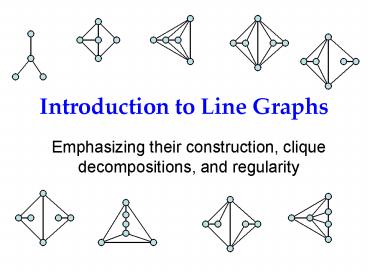Introduction to Line Graphs PowerPoint PPT Presentation
1 / 54
Title: Introduction to Line Graphs
1
Introduction to Line Graphs
- Emphasizing their construction, clique
decompositions, and regularity
2
??
A given graph X
Its line graph L(X)
3
(No Transcript)
4
(No Transcript)
5
(No Transcript)
6
(No Transcript)
7
(No Transcript)
8
(No Transcript)
9
(No Transcript)
10
(No Transcript)
11
(No Transcript)
12
This vertex has degree 1.
so it gives no new adjacencies.
13
(No Transcript)
14
(No Transcript)
15
(No Transcript)
16
This vertex has degree 1.
so it gives no new adjacencies.
17
This vertex also has degree 1.
so it gives no new adjacencies.
18
This vertex has degree 0.
so it gives no new adjacencies.
19
The given graph X
Its line graph L(X)
20
The given graph X
Its line graph L(X)
21
Definition of Line Graph
- Def. Given a graph X(V,E), its line graph is the
graph L(X) with vertex set E and where two
distinct vertices - e and e
- are adjacent iff the corresponding edges in graph
X share an endpoint.
22
Vertices of degree 2
Cliques partitioning edge set
23
Note Each vertex is in 2 of these
cliques.
24
- Thm. (Krausz 1943) Let X be a nonempty simple
graph. Then - X is the line graph of some graph
- if and only if
- the edges of X can be partitioned into cliques so
that each vertex belongs to 2.
25
(No Transcript)
26
(No Transcript)
27
3
2
2
2
3
2
2
2
28
(No Transcript)
29
A vertex in only 1 clique is a pendant. (A deg
0 vertex is an isolated edge.)
30
P is ?-free, so maximal cliques have size 2.
So to cover the edges, each vertex must be in 3
cliques.
So P cannot be a line graph.
31
P is ?-free, so maximal cliques have size 2.
Same problem. So P cannot be a line graph.
So to cover the edges, each vertex must be in 3
cliques.
So P cannot be a line graph.
32
(No Transcript)
33
(No Transcript)
34
Isolated vertices must correspond to isolated
edges.
35
Each clique in the partition corresponds to a
vertex.
36
Two vertices are adjacent iff their cliques
shared a vertex.
37
Vertices belonging to only a single clique
correspond to pendants
38
L(X)
X
Success!!
39
Determining whether such a clique decomposition
exists is computationally impractical for large
graphs.
40
Determining whether such a clique decomposition
exists is computationally impractical for large
graphs. Beineke and Lehot developed a better
approach in the 60s 70s using results of van
Rooij and Wilf.
41
Determining whether such a clique decomposition
exists is computationally impractical for large
graphs. Beineke and Lehot developed a better
approach in the 60s 70s using results of van
Rooij and Wilf.
Theorem. (Beineke, 1968) A simple graph is a
line graph if and only if it has none of the
following as an induced subgraph
42
Alternatively, we could state the result as
follows
Theorem. (Beineke, 1968) A simple graph is a
line graph if and only each induced subgraph on ?
6 vertices is a line graph.
43
Alternatively, we could state the result as
follows
Theorem. (Beineke, 1968) A simple graph is a
line graph if and only each induced subgraph on ?
6 vertices is a line graph.
This narrows the search and in fact, there now
exists a linear time algorithm to test whether a
graph is a line graph! (It also produces such a
graph when the answer is affirmative.)
44
Non-uniqueness of the inverse problem.
This graph is the line graph of each of
the following
45
Non-uniqueness of the inverse problem.
This graph is the line graph of each of
the following
46
Non-uniqueness of the inverse problem.
This graph is the line graph of each of
the following
47
Non-uniqueness of the inverse problem.
This graph is the line graph of each of
the following
48
Non-uniqueness of the inverse problem.
This graph is the line graph of each of
the following
49
BUT the problem is not any worse than these
examples illustrate.
K3
K1,3
Star-Triangle Issue (or claw-triangle)
Theorem. (Whitney, 1932) K3 and K1.3 are the
ONLY pair of non-isomorphic connected graphs
whose line graphs are isomorphic.
50
Finally, some results about regularity and line
graphs.
51
Finally, some results about regularity and line
graphs.
- If X is regular with valency k, then L(X) is
regular with valency 2k-2.
k-1
k-1
52
Finally, some results about regularity and line
graphs.
- If X is regular with valency k, then L(X) is
regular with valency 2k-2.
k-1
k-1
- If X is connected and L(X) is regular, then
either - (i) X is regular, or
- (ii) X is bipartite semi-regular.
a
b
x
y
k
a b k 2 same for any yx.
53
Review of topics
- Definition of line graphs
- Cliques partitioning edges of L(X) using vertices
in X of degree 2 - Beinekes 9 forbidden subgraphs
- Non-uniqueness of inverse problem
- Whitneys star-triangle result
- Regularity and Semiregularity in X and L(X)
54
The End

